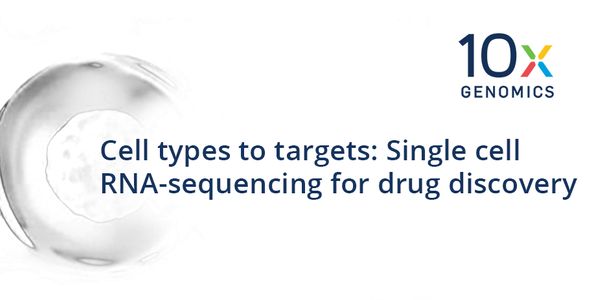Gene Expression
Gene Expression: the process by which information from a gene is used in the synthesis of a functional gene product. These products are often proteins, but in non-protein coding genes such as transfer RNA (tRNA) or small nuclear RNA (snRNA) genes, the product is a functional RNA. The process of gene expression is used by all known life-eukaryotes (including multicellular organisms), prokaryotes (bacteria and archaea), and utilized by viruses-to generate the macromolecular machinery for life.
-
November 13, 2020 4:00 PM PST | November 14, 2020 8:00 AM SGTThree-dimensional (3D) cell culture spheroids and aggregates are preferred over monolayer cell culture due to their architectural and functional similarity to solid tumors. To study expressi...November 12, 2020 9:00 AM PST | 4:00 PM GMTThree-dimensional (3D) cell culture spheroids and aggregates are preferred over monolayer cell culture due to their architectural and functional similarity to solid tumors. To study expressi...NOV 12, 2020 | 12:00 AMImmunohistochemistry (IHC) is used to determine spatial relationships where we can identify the localization of target proteins in specific regions and cells of a tissue. IHC has been the go...NOV 10, 2020 | 9:00 AMDATE: November 10, 2020 TIME: 9:00am PT, 12am ET Gene Synthesis ensures fast access to nearly any DNA sequence, regardless its origin or complexity. Its reliability, flexibility and fast tur...NOV 10, 2020 | 7:00 AMDATE: November 10, 2020 TIME: 7:00am PDT, 10:00am EDT Automation can provide tremendous benefits such as increased pipetting precision and accuracy, productivity, and throughput. Numerous wo...NOV 05, 2020 | 7:00 AMDATE: Date needed, 2020 TIME: Time needed Exosomes are a population of naturally occurring mobile, membrane-limited, 30 – 100 nm in diameter, extracellular vesicles containing a large...Speaker: Jorge Escobar , Aurélie TachenyOCT 29, 2020 | 8:00 AMDate: October 29, 2020 Time: 8:00am (PDT), 11:00am (EDT) What cell types cause and perpetuate disease? For many diseases, scientists only have guesses to this critical question. Single cell...OCT 27, 2020 | 8:00 AMDATE: October 27th, 2020 TIME: 8:00am PT Molecular diagnostic assay development and design is no simple task, and several factors affect the performance and usability of a test. Diagnostic c...OCT 08, 2020 | 3:00 PMThe continued rapid expansion of immunotherapies, including both in vivo and ex vivo therapeutics, has driven the development and adoption of novel tools to study, asses and understand these...Speaker: Benjamin Borgo, PhDOCT 08, 2020 | 12:00 PMAntibodies have become one of the most important tools in life science research, allowing the detection, quantitation, and determination of changes in proteins and other molecules with respe...Speaker: Wayne Speckmann, PhDOCT 08, 2020 | 10:30 AMImmunohistochemistry (IHC) is used to determine spatial relationships where we can identify the localization of target proteins in specific regions and cells of a tissue. IHC has been the go...Speaker: Vivian Barry, MSPresented at: Cancer Research & Oncology Week Virtual Event Series 2020
Sponsored By: Roche DiagnosticsOCT 08, 2020 | 7:30 AMIndividuals of under-represented minority ancestry are at disproportional risk for higher incidence and mortality rates for particular cancers. The unequal burden of cancer in certain racial...Speaker: Steven R. Patierno, PhDOCT 08, 2020 | 7:00 AMDATE: October 8, 2020 TIME: 7:00am PDT, 10:00am EDT, 4:00pm CEST How often do you pipette in your cell culture lab every day? Usually, we do it so often that we tend stop thinking about ho...OCT 08, 2020 | 6:00 AMEvery patient is different and so is every tumor! The term “personalized oncology” today is largely associated with sequencing approaches. Current publications proof more and mor...Speaker: Christian Regenbrecht, PhDPresented at: Cancer Research & Oncology Week Virtual Event Series 2020
Sponsored By: Luminex - A DiaSorin CompanyOCT 08, 2020 | 12:00 AMChanges in transcriptional regulation are thought to be one of the key drivers of carcinogenesis. Although next-generation sequencer revolutionized transcriptome analysis, there are limitati...Speaker: Masahito Kawazu, MDOCT 07, 2020 | 10:30 AMTumor phenotypes are dictated not only by the neoplastic cell component, but also by the tumor microenvironment (TME), which is inherently immuno-suppressive, is equipped to hamper effector...Speaker: Dr. Sergio RutellaPresented at: Cancer Research & Oncology Week Virtual Event Series 2020
Sponsored By: NanoString TechnologiesOCT 07, 2020 | 12:00 AMImmune therapy approaches are being used in many different solid cancers today including clear cell renal carcinoma (mccRCC) and metastatic prostate adenocarcinoma. Over the past few years i...Speaker: Benjamin Maughan, MD, PharmDSEP 30, 2020 | 1:30 PMRNA plays important and diverse roles in biology, but molecular tools to manipulate and measure RNA are limited. We demonstrate that RNA-targeting CRISPR effector Cas13 can be engineered for...Speaker: Omar Abudayyeh, PhD , Jonathan Gootenberg, PhDPresented at: CRISPR Virtual Event Series 2020
SEP 30, 2020 | 12:00 PMThe CRISPR/Cas genome editing system has revolutionized nearly every aspect of the life science industry. Until recently, the most used formats for this technology have been plasmids, mRNA,...Speaker: Gurpreet Balrey, PhD , Peter Romanienko, PhDSEP 30, 2020 | 10:30 AMCRISPR-based genome editing has accelerated biological research and holds great potential for studying and treating human diseases. The CRISPR-Cas9 system requires a Cas9 nuclease and a guid...Speaker: James Goldmeyer, PhDSEP 30, 2020 | 9:00 AMWhile transformative, first-generation CRISPR technologies remain limited across multiple important dimensions including scalability, editing efficiency, types of modifications available, an...Speaker: Nandini Krishnamurthy, PhDSEP 30, 2020 | 7:30 AMGenome Engineering allows the easy manipulation of genomes down to the nucleotide level. Targeted deep sequencing enables the detection and quantification of low-frequency editing events. Ho...SEP 30, 2020 | 6:00 AMGenome editing with an expanded CRISPR-Cas tool set increases the opportunity to make intentional, targeted changes in the genome. Furthermore, improved specificity of genome editing and abi...SEP 30, 2020 | 12:00 AMThe adenosine analogue remdesivir has emerged as a front-line antiviral treatment for SARS-CoV-2, with preliminary evidence that it reduces the duration and severity of illness. Prior clinic...
November 13, 2020 4:00 PM PST | November 14, 2020 8:00 AM SGT
Three-dimensional (3D) cell culture spheroids and aggregates are preferred over monolayer cell culture due to their architectural and functional similarity to solid tumors. To study expressi...
November 12, 2020 9:00 AM PST | 4:00 PM GMT
Three-dimensional (3D) cell culture spheroids and aggregates are preferred over monolayer cell culture due to their architectural and functional similarity to solid tumors. To study expressi...
NOV 12, 2020 | 12:00 AM
Immunohistochemistry (IHC) is used to determine spatial relationships where we can identify the localization of target proteins in specific regions and cells of a tissue. IHC has been the go...
NOV 10, 2020 | 9:00 AM
DATE: November 10, 2020 TIME: 9:00am PT, 12am ET Gene Synthesis ensures fast access to nearly any DNA sequence, regardless its origin or complexity. Its reliability, flexibility and fast tur...
NOV 10, 2020 | 7:00 AM
DATE: November 10, 2020 TIME: 7:00am PDT, 10:00am EDT Automation can provide tremendous benefits such as increased pipetting precision and accuracy, productivity, and throughput. Numerous wo...
NOV 05, 2020 | 7:00 AM
DATE: Date needed, 2020 TIME: Time needed Exosomes are a population of naturally occurring mobile, membrane-limited, 30 – 100 nm in diameter, extracellular vesicles containing a large...
Speaker:
Jorge Escobar
, Aurélie Tacheny
OCT 29, 2020 | 8:00 AM
Date: October 29, 2020 Time: 8:00am (PDT), 11:00am (EDT) What cell types cause and perpetuate disease? For many diseases, scientists only have guesses to this critical question. Single cell...
OCT 27, 2020 | 8:00 AM
DATE: October 27th, 2020 TIME: 8:00am PT Molecular diagnostic assay development and design is no simple task, and several factors affect the performance and usability of a test. Diagnostic c...
OCT 08, 2020 | 3:00 PM
The continued rapid expansion of immunotherapies, including both in vivo and ex vivo therapeutics, has driven the development and adoption of novel tools to study, asses and understand these...
Speaker:
Benjamin Borgo, PhD
OCT 08, 2020 | 12:00 PM
Antibodies have become one of the most important tools in life science research, allowing the detection, quantitation, and determination of changes in proteins and other molecules with respe...
Speaker:
Wayne Speckmann, PhD
OCT 08, 2020 | 10:30 AM
Immunohistochemistry (IHC) is used to determine spatial relationships where we can identify the localization of target proteins in specific regions and cells of a tissue. IHC has been the go...
Speaker:
Vivian Barry, MS
Presented at: Cancer Research & Oncology Week Virtual Event Series 2020
Sponsored By: Roche Diagnostics
Sponsored By: Roche Diagnostics
OCT 08, 2020 | 7:30 AM
Individuals of under-represented minority ancestry are at disproportional risk for higher incidence and mortality rates for particular cancers. The unequal burden of cancer in certain racial...
Speaker:
Steven R. Patierno, PhD
OCT 08, 2020 | 7:00 AM
DATE: October 8, 2020 TIME: 7:00am PDT, 10:00am EDT, 4:00pm CEST How often do you pipette in your cell culture lab every day? Usually, we do it so often that we tend stop thinking about ho...
OCT 08, 2020 | 6:00 AM
Every patient is different and so is every tumor! The term “personalized oncology” today is largely associated with sequencing approaches. Current publications proof more and mor...
Speaker:
Christian Regenbrecht, PhD
Presented at: Cancer Research & Oncology Week Virtual Event Series 2020
Sponsored By: Luminex - A DiaSorin Company
Sponsored By: Luminex - A DiaSorin Company
OCT 08, 2020 | 12:00 AM
Changes in transcriptional regulation are thought to be one of the key drivers of carcinogenesis. Although next-generation sequencer revolutionized transcriptome analysis, there are limitati...
Speaker:
Masahito Kawazu, MD
OCT 07, 2020 | 10:30 AM
Tumor phenotypes are dictated not only by the neoplastic cell component, but also by the tumor microenvironment (TME), which is inherently immuno-suppressive, is equipped to hamper effector...
Speaker:
Dr. Sergio Rutella
Presented at: Cancer Research & Oncology Week Virtual Event Series 2020
Sponsored By: NanoString Technologies
Sponsored By: NanoString Technologies
OCT 07, 2020 | 12:00 AM
Immune therapy approaches are being used in many different solid cancers today including clear cell renal carcinoma (mccRCC) and metastatic prostate adenocarcinoma. Over the past few years i...
Speaker:
Benjamin Maughan, MD, PharmD
SEP 30, 2020 | 1:30 PM
RNA plays important and diverse roles in biology, but molecular tools to manipulate and measure RNA are limited. We demonstrate that RNA-targeting CRISPR effector Cas13 can be engineered for...
Speaker:
Omar Abudayyeh, PhD
, Jonathan Gootenberg, PhD
Presented at: CRISPR Virtual Event Series 2020
SEP 30, 2020 | 12:00 PM
The CRISPR/Cas genome editing system has revolutionized nearly every aspect of the life science industry. Until recently, the most used formats for this technology have been plasmids, mRNA,...
Speaker:
Gurpreet Balrey, PhD
, Peter Romanienko, PhD
SEP 30, 2020 | 10:30 AM
CRISPR-based genome editing has accelerated biological research and holds great potential for studying and treating human diseases. The CRISPR-Cas9 system requires a Cas9 nuclease and a guid...
Speaker:
James Goldmeyer, PhD
SEP 30, 2020 | 9:00 AM
While transformative, first-generation CRISPR technologies remain limited across multiple important dimensions including scalability, editing efficiency, types of modifications available, an...
Speaker:
Nandini Krishnamurthy, PhD
SEP 30, 2020 | 7:30 AM
Genome Engineering allows the easy manipulation of genomes down to the nucleotide level. Targeted deep sequencing enables the detection and quantification of low-frequency editing events. Ho...
SEP 30, 2020 | 6:00 AM
Genome editing with an expanded CRISPR-Cas tool set increases the opportunity to make intentional, targeted changes in the genome. Furthermore, improved specificity of genome editing and abi...
SEP 30, 2020 | 12:00 AM
The adenosine analogue remdesivir has emerged as a front-line antiviral treatment for SARS-CoV-2, with preliminary evidence that it reduces the duration and severity of illness. Prior clinic...






















